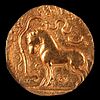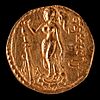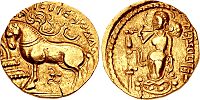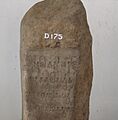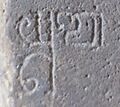Yūpa facts for kids
A Yūpa (pronounced Yoo-pah) was a special pillar used in ancient India during important religious ceremonies. These pillars were a key part of Vedic rituals, which were ancient traditions and beliefs. People believed that performing these rituals, sometimes involving animals tied to the yūpa, would bring good luck and prosperity to everyone.
Most yūpas were made of wood and have not survived over thousands of years. However, a few stone yūpas have been found. These stone pillars were likely built later, copying the look of the older wooden ones. The most complete stone yūpa, called the Isapur Yūpa, even has carvings that look like the ropes used to tie animals. The very top part of these pillars is often missing, but old texts describe a "wheel-like" top, possibly representing the sun.
The Famous Isapur Yūpa
The Isapur Yūpa is a very important stone pillar that you can see today in the Mathura Museum. It was discovered in a place called Isapur, close to the city of Mathura. This pillar has an inscription (writing carved into it) that tells us about a Kushan ruler named Vāsishka from the 3rd century CE. The inscription says that this Yūpa pillar was set up for a special religious ceremony.
-
The word "Yūpaḥ" written in the ancient Brahmi script on the Isapur pillar.
Yūpa on Ancient Coins
During the time of the Gupta Empire, which was a powerful kingdom in ancient India, yūpa pillars even appeared on coins! For example, coins from the ruler Samudragupta show a horse standing in front of a yūpa. This scene represents a very important horse sacrifice ceremony called the Ashvamedha.
On the other side of these coins, you might see the queen holding a chowrie (a type of fan) for the horse and a pointed tool. The words on the coin often say things like "The King of Kings, who had performed the Ashvamedha sacrifice, wins heaven after conquering the earth."
-
A coin of Samudragupta showing a horse in front of a yūpa pillar. The words on the coin talk about the king performing the Ashvamedha sacrifice.
Yūpa Inscriptions in Indonesia
Did you know that yūpa pillars were also found far away in Indonesia? The oldest known Sanskrit writings in the Indonesian islands are on seven stone pillars, or Yūpa, found in the eastern part of Borneo. These pillars are from the historical area of Kutai.
These inscriptions were written by Brahmins (religious scholars) using an early form of the Pallava script and the Sanskrit language. They were made to remember important ceremonies held by a generous and powerful king named Mulavarman. He ruled the Kutai Martadipura Kingdom, which was the first Hindu kingdom in what is now Indonesia. Experts believe these pillars were made in the second half of the 4th century CE. They show that Indian culture and religion had reached Indonesia even before 400 CE.
The inscriptions mention King Mulavarman, his father Aswawarman, and his grandfather Kudungga, who founded the kingdom. Aswawarman was the first in his family to have a Sanskrit name, which suggests he was likely the first to follow Hinduism.
-
One of the yūpa inscriptions from Kutai made by King Mulavarman. It is now at the National Museum in Jakarta.
The four main Yūpa inscriptions found in Indonesia are called "Muarakaman" inscriptions. They tell us about King Mulavarman's good deeds and gifts. For example, one inscription talks about him giving 20,000 cows to the Brahmins in a holy place. These inscriptions are important because they give us a glimpse into the history and religious practices of ancient Indonesian kingdoms.
Today, these valuable Yūpa pillars from Indonesia are kept safe in the National Museum of Indonesia in Jakarta.







